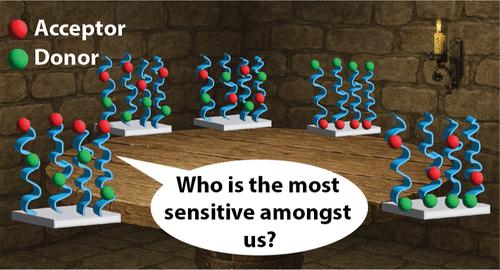fret集成聚合物刷:探测链构象最敏感的结构是什么?
IF 5.2
1区 化学
Q1 POLYMER SCIENCE
引用次数: 0
摘要
聚合物刷表面提供了令人兴奋的可能性,作为基于表面的传感装置,其中刷子构象的变化可以作为感知刺激的基础。最近,Förster共振能量转移(FRET)化学已被集成到功能性聚合物刷中,这使得由于刷内成对荧光团之间的纳米级接近变化,可以在空间上探测构象变化。然而,FRET荧光团可以在画笔内以各种不同的结构排列(例如,在链端,分散在内部等),这就导致了一个问题:在画笔内探测构象的FRET荧光团最敏感的排列是什么?在这里,我们从多个方向来解决这个问题。我们设计了一个电刷的数学模型,该模型将FRET结构视为定义荧光团密度的连续体,并推导出FRET效率作为体之间距离的函数。对于基于实验的参数(电刷高度、接枝密度等),我们发现双嵌段无规共聚物结构是最敏感的,其次是分散在电刷内的供体荧光团,受体位于链端。我们通过模型刷系统的粗粒度分子动力学模拟来补充这一点,并计算FRET效率作为刷高度的函数。结果与我们的模型一致,我们发现相同的两个刷架构是最敏感的。最后,我们从最近的实验测量中比较了这些架构的灵敏度,结果表明我们的模型和仿真都是合理的。我们的研究结果将告知该领域将FRET化学整合到功能聚合物刷中的最佳方法,以获得最大的构象灵敏度。本文章由计算机程序翻译,如有差异,请以英文原文为准。

FRET-Integrated Polymer Brushes: What is the Most Sensitive Architecture for Probing Chain Conformation?
Polymer brush surfaces offer exciting possibilities as surface-based sensing devices, where changes in brush conformation can be used as a basis to sense stimuli. Recently, Förster resonance energy transfer (FRET) chemistry has been integrated into functional polymer brushes, which allowed for conformational changes to be spatially probed due to nanoscale proximity changes between paired fluorophores within the brushes. However, the FRET fluorophores can be arranged in a variety of different architectures within brushes (e.g., on chain ends, dispersed within, etc.), which leads to the question: what is the most sensitive arrangement of FRET fluorophores within a brush for probing conformation? Herein, we address this question from multiple directions. We devise a mathematical model of a brush which considers FRET architectures as continuous bodies of defined fluorophore density, and derive the FRET efficiency as a function of distances between bodies. For experimental based parameters (brush height, grafting density, etc.), we find that diblock random copolymer architectures are the most sensitive, followed closely by donor fluorophores dispersed within the brush, with acceptors on the chain ends. We complement this by coarse grained molecular dynamics simulations of model brush systems, and calculate the FRET efficiency as a function of brush height. The results are consistent with our model, where we find the same two brush architectures to be the most sensitive. Lastly, we compare these architectures for sensitivity from recent experimental measurements, which demonstrated reasonable agreement with both our model and simulation. Our results will inform the field on the best ways of integrating FRET chemistry into functional polymer brushes for greatest conformational sensitivity.
求助全文
通过发布文献求助,成功后即可免费获取论文全文。
去求助
来源期刊

Macromolecules
工程技术-高分子科学
CiteScore
9.30
自引率
16.40%
发文量
942
审稿时长
2 months
期刊介绍:
Macromolecules publishes original, fundamental, and impactful research on all aspects of polymer science. Topics of interest include synthesis (e.g., controlled polymerizations, polymerization catalysis, post polymerization modification, new monomer structures and polymer architectures, and polymerization mechanisms/kinetics analysis); phase behavior, thermodynamics, dynamic, and ordering/disordering phenomena (e.g., self-assembly, gelation, crystallization, solution/melt/solid-state characteristics); structure and properties (e.g., mechanical and rheological properties, surface/interfacial characteristics, electronic and transport properties); new state of the art characterization (e.g., spectroscopy, scattering, microscopy, rheology), simulation (e.g., Monte Carlo, molecular dynamics, multi-scale/coarse-grained modeling), and theoretical methods. Renewable/sustainable polymers, polymer networks, responsive polymers, electro-, magneto- and opto-active macromolecules, inorganic polymers, charge-transporting polymers (ion-containing, semiconducting, and conducting), nanostructured polymers, and polymer composites are also of interest. Typical papers published in Macromolecules showcase important and innovative concepts, experimental methods/observations, and theoretical/computational approaches that demonstrate a fundamental advance in the understanding of polymers.
 求助内容:
求助内容: 应助结果提醒方式:
应助结果提醒方式:


